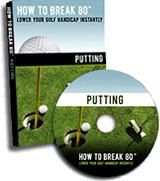Course Management 101: Damage Control
By Jack Moorehouse
No matter how many golf lessons you take, there's no "silver bullet" in golf. There's no one thing that will suddenly change you from a player with a high golf handicap to one with a low golf handicap. Regardless of how much talent you have, how expensive your equipment, or how many golf lessons you take, you must work on the fundamentals of the golf swing to improve.
But there are ways of improving your game that don't involve swinging a club. After ironing out the fundamentals of the golf swing, the fastest way for a 90-plus player to become and an 80-plus player is by improving his or her course management skills. And in golf that general means learning the fine art of damage limitation—something the top players in the world, like Tiger, Vijay, and Phil, all excel at.
Be Like Jack
Jack Nicklaus is probably the best model for anyone trying to improve his or her course management skills. Nicklaus took the art of damage limitation to a new level. He rarely hit the wrong shot at the wrong time, or gambled when the odds were too heavily stacked against him. His approach paid off. He still has the record for winning the most majors, among other things.
You can sum up Nicklaus' course management philosophy—and that of almost every other top player—using two fundamental ideas: (1) find the easiest way and (2) avoid danger. Using these ideas as the foundation of your course management strategy can propel you to better scores and a lower golf handicap, even if you have limited ball-striking ability or have a poor short game.
Finding the Way
A golf course can be looked at as an obstacle course in which there are easier ways and more difficult ways to get around. One of the keys to scoring well, even on days when you're not playing your best, is finding the easiest path around the course. That generally means taking fewer shoots. This principal may not help you shoot scores low enough to win a tournament, but it will help you limit shooting those ultra high scores that can boost your handicap and shatter your confidence.
Avoid Danger
Learning to avoid potential disasters can dramatically improve your scores. Every round has critical shots. Played poorly these shots can radically affect your scores. These shots may include your drives, approach shots, chips, putts, or any combination of these shots; but whatever they are, they cost you strokes or maybe the hole when misplayed. How we assess these shots and deal with them makes the difference between good scores and bad scores.
Basic Management Strategies
Using these two principals as our foundation, let's look at four basic management strategies that can help you guide you around the course to achieve better scores.
1. Carrying Over Water
If you're not certain you can carry over water with anything but your career best shot, don't try it. It's not worth the risk. Lay up instead. Then try for a pitch and putt. You have a chance at pulling it off, and even if you don't, the worst that could happen is dropping a stroke. Failure to carry the water is doubly damaging. It can affect both your score and your confidence.
If you happen to catch the playoff hole between Zach Johnson and Ryuji Imada at the AT&T Classic (TPC Sugarloaf) on Sunday, you saw the damage not laying up can bring. Imada's tee shot landed in the left side of the rough and his 3-wood failed to clear the water, costing him the tournament. If he had laid-up instead, he could still have ended up birding the hole with a pitch and a putt. That would have put pressure on Johnson and probably kept Imada alive for another hole.
2. Playing Long Holes
When playing long par 4s where you know you can't hit the green in two, decide from where ideally you'd like to play your third shot to give you the best chance of making par. Don't force your drive and don't force your second shot. Keep the ball in play. Remember while a par is better than a bogie, a bogie is better than a seven. Every shot counts.
3. Approaching the Green
You don't always have to attack the hole with your approach shot. It's sometimes much easier to hole out with two putts from the center of the green, no matter where the hole is, rather than have to get up and down from a green side bunker because your approach shot was just a fraction or so off line or a foot or so short.
4. Safety First
Sooner or later we're all going to get into trouble. You may find yourself in deep rough or up against an obstacle. Whatever the problem, the golden rule is safety first. Concentrate solely on getting back into the fairway in a good position to hit the next shot, and you will minimize the damage down by your original miscue.
Golf instruction sessions can help you iron out your swing fundamentals and improve your scores. But if you really want to become a top-notch player with a low golf handicap, you need to supplement your golf lessons by working on your course management skills. Base your strategy on two key principals—find the easiest way around the course and avoid danger—and you'll see your scores and golf handicap quickly improve.
Jack Moorehouse is the author of the best-selling book "How To Break 80 And Shoot Like The Pros." He is NOT a golf pro, rather a working man that has helped thousands of golfers from all seven continents lower their handicap immediately. He has a free weekly newsletter with the latest golf tips, golf lessons and golf instruction.
|






